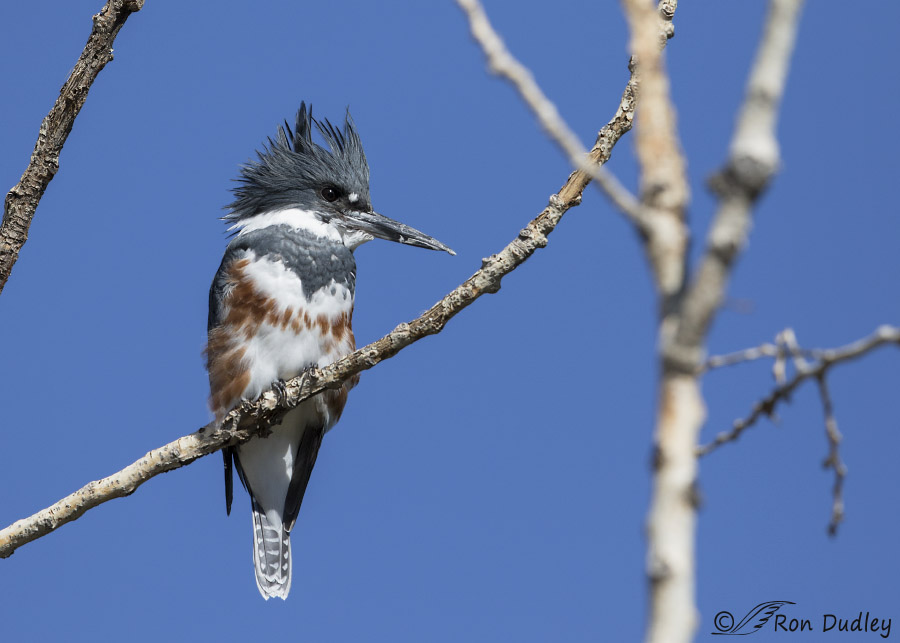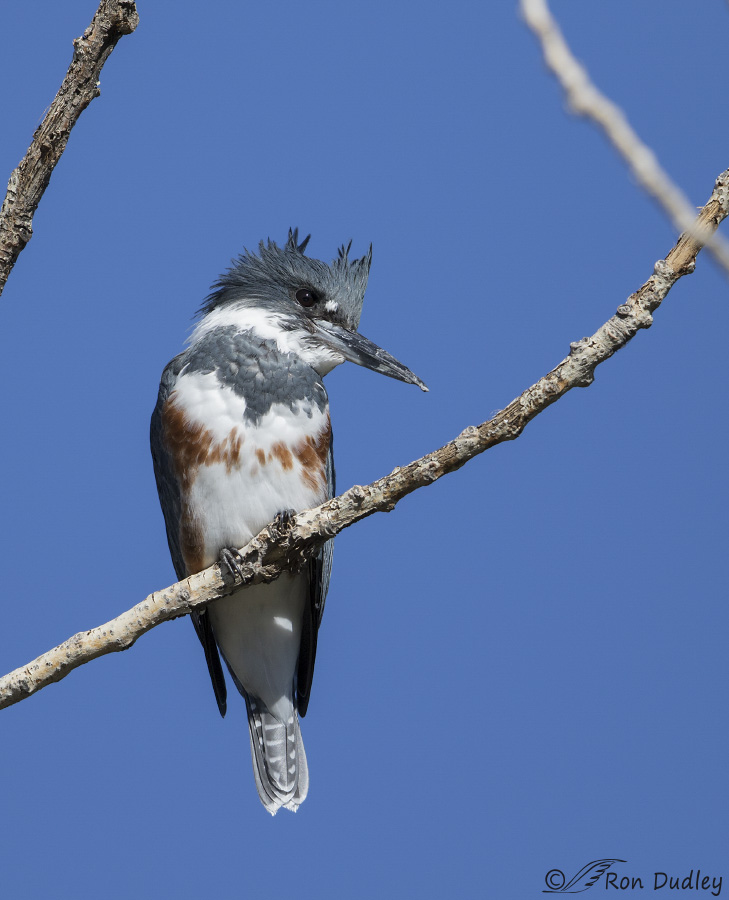This female Belted Kingfisher continues to taunt me.

1/4000, f/7.1, ISO 320, Canon 7D Mark II, Canon EF 500mm f/4L IS II USM, not baited, set up or called in
She appears regularly at a local pond near my home but great photos of her continue to elude me. She allows me close but her favorite fishing perch is high in a tree and cluttered with branches. And on those occasions when she successfully dives on a fish she always hauls it across the pond to a faraway tree before knocking it senseless on a branch and then gulping it down.
This composition includes lots of blurry branches on the right so I…

1/4000, f/6.3, ISO 320, Canon 7D Mark II, Canon EF 500mm f/4L IS II USM, not baited, set up or called in
actually prefer a vertical crop that gets rid of most of them.
In sexually dimorphic bird species males are nearly always more colorful than females. In the few exceptions to that rule there’s a reversal of sex roles where the males tend to the nest instead of the females – phalaropes are one example of that. But in sexually dimorphic Belted Kingfishers the bright rusty-red belt across the lower breast of the female makes her more colorful than the male who lacks it but there’s no sex role reversal. What’s going on?
It may be explained in combination with yet another quirky trait of the species. Belted Kingfishers are highly territorial and the males often (though not always) remain on their territories year-round so they don’t give up prime nesting territory and have to compete for it again in the spring. The females, on the other hand, migrate south for the winter.
So one theory suggests the female is more colorful as a visual signal to a resident male that he should welcome a returning kingfisher with a rusty-red belt in the spring instead of chasing her off. But researchers admit they don’t know that for sure and suggest further research is needed.
Whatever the explanation “my” female will likely be gone soon so I’ll probably be making many more trips down the hill to the pond before she departs.
Ron
Note: I should make it clear that female kingfishers in regions that are less cold often don’t migrate.


Ron, beautiful photos.
I think that she has a New York attitude and hair style, having lived there for several decades.
I enjoy you daily posts and the beauty of the birds. As a result my husband and I have taken a much greater interest in the birds of Northern Utah.
Thank you again for opening up a whole new world for us.
Alice, I loved hearing that because of my blog you and your husband have become more interested in our birds. Music to my ears…
In explaining the color of the female, I just think of it as a shade of brown. Therefore, she is less colorful than the male. Don’t know if this has any scientific validity, but it works for me!
Interesting perspective, Aimee…
Learning all the time. Thank you. The colour so she can be welcomed back in Spring does make sense doesn’t it?
And, like Patty, I love her do. And would welcome a Patty do photo.
There’s another theory to explain the behavior too, EC (can’t remember what it was at the moment…) but this one seemed more likely to me.
Beautiful bird, A couple of years ago when I was regularly riding my bike on the Jordan River Trail I was surprised by how many Kingfishers I saw along the way. Are there many males that stay all winter? How late do the females stay?
I don’t really know the answer to either question, April. I just know I’ve seen kingfishers in winter around here.
Both shots of this bird are beautiful…like the first slightly better….very interesting information…makes me curious as usual, I wonder what the males eat in the winter if water is frozen??? And where the females go…how far they travel…and if they return to the mate…and when.(I like the way she gels her hair…might try it myself)…
Patty, around here the resident males can usually find water that isn’t frozen unless it’s an unusually cold winter. Many of the migrating birds spend the winter in the southwest states and Mexico.
If you decide to copy that hairdo please send me a photo so I can post it on Feathered Photography as an example of mimicry…
Deal!
I think this bird is probably my favorite of all the birds you’ve posted on more than one occasion. I guess in a way we’ve gotten to know her because you have spent a lot of time photographing her. I always enjoy any kind of Kingfisher.
I have similar feelings about her, Susan. Like friends sometimes do she occasionally tries my patience but she sure delights me most of the time.
The branches don’t bother me either- my eyes were drawn immediately to the bird. I love the the info regarding migration- makes me feel a little less guilty about lingering over my coffee this morning!
Diane, one should NEVER feel guilty about lingering over coffee! That’s something I’m doing at this very moment…
Fantastic shots and interesting info Ron!
Charlotte
Thank you, Charlotte.
Very nice shots, Ron. As you know branches don’t bother me, the shot of the bird is what is important, and you have it spot on!!
I’m wondering if the reason she goes across the pond is because the branch on which she beats the fish is bigger, sturdier and allows her safety from an avian thief?
Also wonder whether her rusty belt has anything to do with the fact that they nest in burrows along a stream bank and whether that would help her during her egg laying and brooding?
Thanks, Dick. I’m not sure why she goes across the pond.
You could be right but another possibility is safety. The tree she fishes from is mostly dead with no leaves which gives her a clear view of the pond but it also makes her vulnerable to predators. About a week ago while I was watching her a Cooper’s Hawk swooped in an came VERY close to grabbing her. She barely escaped to the same trees where she eats the fish and holy hell, did she ever make a racket for a while! She was very disturbed by her close call and I don’t blame her.
I like the images Ron of these beautiful birds. Nice and sharp on the bird, the branches add some nice realism and seasoning.
Interesting that the females migrate and the males stay. Thanks for that education.
They are tricky to photograph as they seem to be spooked easily. I often wonder if the cartoon character “Woody the Woodpecker” has more behavioral traits of the Kingfisher than a woodpecker (this is real science here 🙂 ) . The kingfishers are always vocalizing like “Woody” whenever I approach the local farm ponds. I will read more about the migration and learn more about these favorite photography subjects.
I found out that cheating (low-life) photographers will place a plastic bag, or glass jar, with live minnows in it, underwater in a predetermined location so they can pre-focus on a spot and get an image of them diving into the water (at the baited setup). Pretty weak and pathetic…
These frauds are missing out on the fun and challenge of trying to photograph them fishing.
Two years ago I became bored and saturated with bear photos in SE Alaska and decided to spend a full day photographing kingfishers in an estuary. That was the best decision I made for that trip! I ended up spending a few more days just sitting patiently watching them and photographing them.
Have you watched them kill their prey once they catch a small fish yet? It is a very interesting ritual, where then repeatedly beat the fish on a branch or rock, almost looking as if they are showing off and enjoying this.
“Have you watched them kill their prey once they catch a small fish yet?”
Yes, multiple times. I also photographed that behavior and in the link below you can see the wet spot on the branch caused by the fish as the kingfisher bashed it.
https://www.featheredphotography.com/blog/2016/02/18/belted-kingfisher-stunning-tossing-and-swallowing-prey/
I’m aware of a well known bird photographer who shoots kingfisher setups by putting goldfish in a plastic kiddie pool and placing attractive set-up perches around the pool. “Low-lifes” is right.
Nice detail in the shot and I like the position of her head! 🙂 The vertical crop does improve the photo. 🙂 Thx for the biology lesson along with the photo’s. 🙂
Judy, I can’t resist throwing in a little natural history/biology when I think it’s appropriate. Thank you.